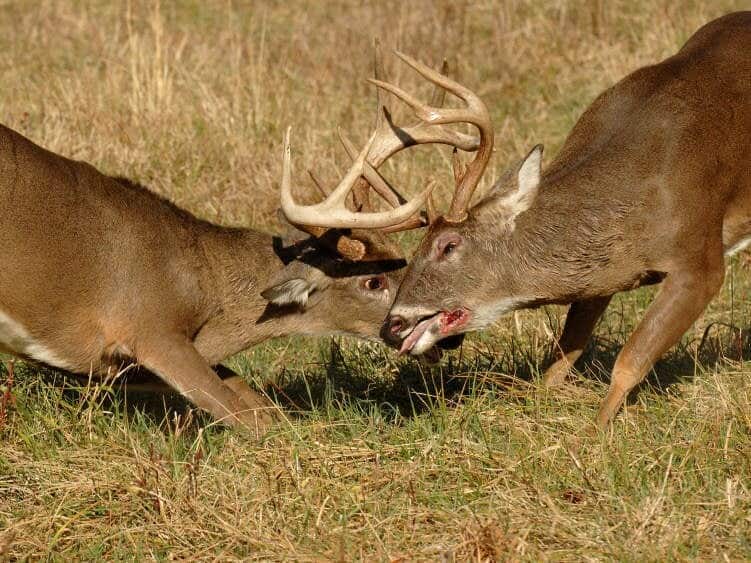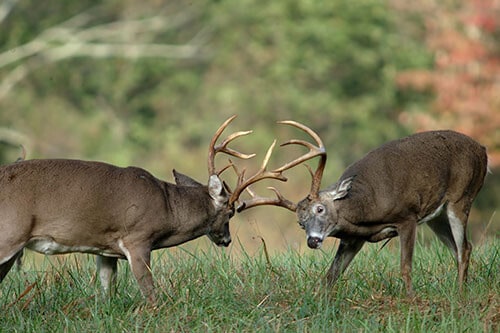Rattling is an effective strategy to bring in bucks looking for a fight, or just curious ones, but when is the best time to rattle? Well, that can be hard to say because, to be honest, rattling always does a good job at getting the attention of deer in the area. However, that does not mean that you should rattle nonstop. With a little strategy, we can rattle much more effectively.
Compared to evenings, hunters on average have had better success rattling in the morning just an hour or so after daylight. Results from rattling can vary between populations, but as a general rule of thumb, rattling is more effective in the morning but is still viable during evening hours.

There are plenty of advantages to rattling during both the morning and evening and those even change throughout the year. So, let’s take a look at the survey I conducted and dive into those advantages after.
Survey Results
The straightforward answer to this question would be for me to say whether I personally think rattling is better in the morning or evening, but it would be better to get a general consensus from many hunters and not just answer based on my personal experience alone.
So, I conducted a survey both on Facebook and around hunting forums to see whether hunters have had better success in the mornings, evenings, or equal success during both. Here is what I found.
As you can see from the pie chart, 48% of hunters reported having more success rattling in the morning vs the evening. Plus, if you combine that with the 33% of hunters that had equal success rattling during both, 81% of hunters had success rattling during morning hunts.
On the flip side, a combined 52% of hunters have had repeated success rattling during the evenings. This tells us that both times of the day are obviously viable times to try rattling, but if you want to try other tactics like blind grunting, you should hold off on that until the evening.
With that being said, different populations of whitetail react differently to certain calls. So, the whitetail in your area may very well react more to rattling during the evening. All this data says is that on average, most hunters have better success during the morning. Although it cannot hurt to try both and see what is better in your area.
What Science Has to Say About Rattling Timing
Dr. Mickey Hellickson conducted a study in South Texas around deer rattling. This study took place from 1992 through 1995 on the welder wildlife refuge. This refuge is 7800 acres large and is not hunted, which means the deer structure has more mature deer and is a prime location to try this study.
Plus on this refuge, there are 17 30 foot observation towers. Hellickson had two-man teams use these towers to conduct the experiment. One man would stand at the bottom of the tower and another would be in the tower watching over the area. They also mentioned that in the specific terrain of the refuge they were able to see out to 500 yards in these towers.
They then used four different types of rattling, long and soft, long and hard, short and soft, as well as short and hard. All sessions were 30 minutes long, but during the short sessions, they rattled for 1 minute and waited for 9 minutes. They repeated this two more times. Likewise, with the long sessions, they rattled for 3 minutes and waited for 7 minutes.

They then rattled throughout the day and had a recorded 171 sessions. 111 of which had bucks respond to the rattling sequence. Here is a tabulated list of their results.
- More bucks responded to loud rattling rather than soft
- Most bucks responded in the first 10 minutes of rattling
- 54% of bucks responded in the morning, 30% responded during the evening and only 16% of bucks responded during midday.
- The highest number of bucks responded during the peak rut, followed by the post-rut, and the fewest bucks responded during the pre-rut.
- Mature bucks were more likely to respond during the post-rut, whereas younger and middle age bucks responded during the peak rut.
Dr. Mickey Hellickson actually did a podcast with Mississippi State’s podcast Deer University, which you can listen to here.
As we can see, Hellickson’s study is consistent with our survey which shows that whitetail responds the most during the morning hours rather than the evening. Although, both morning and evening are much better than mid-day.
How To Rattle in Mature Bucks
As we can see from Hellickson’s study, the best way to rattle in bucks is with loud aggressive rattling. You see a lot of people recommend that you are just supposed to lightly rattle and imitate a sparring session. Since sparring sessions account for 90% of buck fights, they are less likely to attract much attention.
Instead, loud aggressive fights signal to other bucks in the area that there is likely a doe in estrus in the area that the two other bucks obviously think is worth fighting over. This is a perfect opportunity for a buck to come over and breed this estrus doe while the other bucks are busy.
If you really want to sell the aggressive rattling, then I would suggest that you spread around some doe scent before you climb up your stand. Not only will this hopefully bring bucks in on its own, but if you rattle in a buck close enough he will smell the estrus and that will further entice him to come in and breed her.
To do this kind of aggressive rattling, I suggest using some sturdy antlers or a Black Rack. Black Rack has always worked wonders for me and they will last. Pick up one here on amazon.
The Best Time of Year to Rattle in Bucks
Rattling also has different effects on deer during different phases of the rut. As we can see from Hillickson’s study, rattling is going to bring in the most amount of deer during the peak rut. Which is what we would expect. During this time, bucks are going to be very active and they are also very aggressive. So, I would set up around funnels and pinch points and rattle every so often. If you want to learn how to hunt funnels and pinch points, I have another article on it here.
A lot of hunters will tell you that rattling works the best during the pre-rut. This is something that I also thought to be true before seeing Hellickson’s study. From his numbers, the pre-rut is actually the worst time to bring in bucks. While it did work, there were not nearly as many bucks responding as compared to the peak rut.
The post-rut activity that Hellickson observed may come as a surprise to most, but it makes sense if you think about it. During the post-rut, more deer responded to rattling than the pre-rut but not as many as the peak rut. Plus, the bucks that did respond to rattling were larger and more mature on average.
During the post-rut, many bucks are falling back into bachelor groups. However, mature bucks are still out there looking for does that are just coming into estrus. So, since there are fewer does in estrus and fewer young bucks chasing, this is the time to shine for rattling. When a buck hears a rattle during this time he knows that there is one of the last estrus does of the year nearby and he is more than willing to fight for her.
Thank you for reading my article! I hope you enjoyed it, and if you have any questions or feedback, please send me an email at [email protected]. If you want to learn more about me or Omega Outdoors, visit my About Page. Otherwise, I hope you have a great day, and check out some of my other articles while you’re here!

